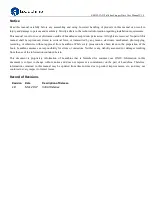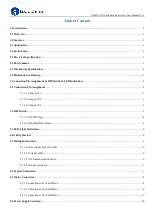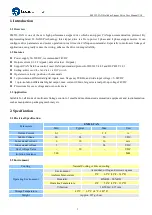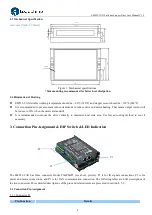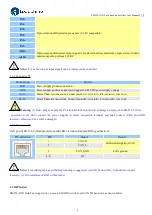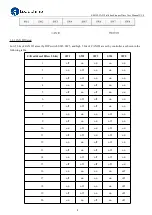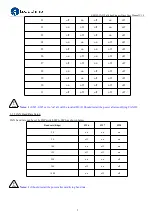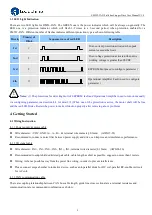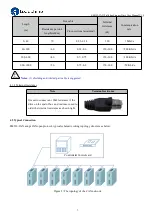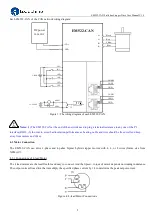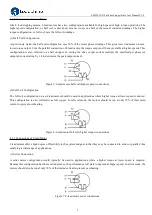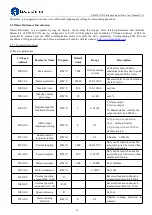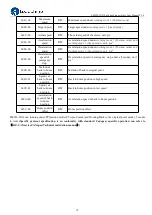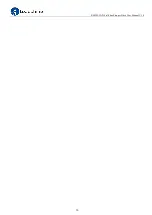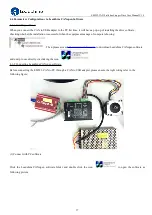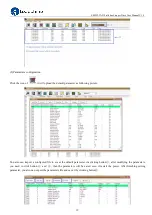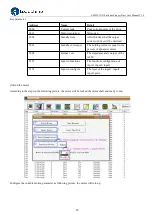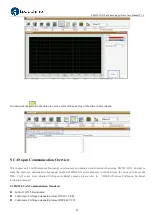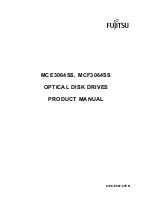
EM522-CAN Field bus Stepper Drive User Manual V1.0
10
(2) Parallel Connection
An 8 lead motor in a parallel configuration offers a more stable, but lower torque at lower speeds. But because of the lower
inductance, there will be higher torque at higher speeds. Multiply the phase (or unipolar) current rating by 1.96, or the bipolar
current rating by 1.4, to determine the peak output current.
Figure 8: 8-lead motor parallel connections
4.4 Power Supply Selection
The EM522-CAN can power medium and small size stepping motors (frame size from NEMA17 to 24) made by Leadshine
or other motor manufacturers. To get good driving performances, it is important to select supply voltage and output current
properly. Generally speaking, supply voltage determines the high speed performance of the motor, while output current
determines the output torque of the driven motor (particularly at lower speed). Higher supply voltage will allow higher motor
speed to be achieved, at the price of more noise and heating. If the motion speed requirement is low, it’s better to use lower
supply voltage to decrease noise, heating and improve reliability.
4.4.1 Regulated or Unregulated Power Supply
Both regulated and unregulated power supplies can be used to supply the drive. However, unregulated power supplies are
preferred due to their ability to withstand current surge and fast response for current change. If you prefer to a regulated
power supply, it is suggested to choose such a power supply specially designed for stepper/servo controls such as Leadshine
RPS series (
http://www.leadshine.com/producttypes.aspx?producttype=regulated-switching
). Or, in the case when only
normal switching power supplies are available, it is important to use “OVERSIZE” high current output rating power supplies
(for example, using a 4A power supply for 3A stepper motor) to avoid problems such as current clamp. On the other hand, if
unregulated supply is used, one may use a power supply of lower current rating than that of motor (typically 50%~70% of
motor current). The reason is that the drive draws current from the power supply capacitor of the unregulated supply only
during the ON duration of the PWM cycle, but not during the OFF duration. Therefore, the average current withdrawn from
power supply is considerably less than motor current. For example, two 3A motors can be well supplied by one power supply
of 4A rating.
4.4.2 Power Supply Sharing
Multiple EM522-CAN drives can share one power supply to reduce cost, if that power supply has enough power capacity. To
avoid cross interference, connect each stepper drive directly to the shared power supply separately. To avoid cross
interference, DO NOT daisy-chain connect the power supply input pins of the Drivers. Instead connect them to power supply
separately.
4.4.3 Selecting Supply Voltage
The EM522-CAN is designed to operate 20 - +50VDC voltage input. When selecting a power supply, besides
voltage from the power supply power line voltage fluctuation and back EMF voltage generated during motor deceleration
needs also to be taken into account. Ideally it is suggested to use a power supply with the output range of +24 - +48 VDC,
leaving room for power line voltage fluctuation and back-EMF.
Higher supply voltage can increase motor torque at higher speeds, thus helpful for avoiding losing steps. However, higher
voltage may cause bigger motor vibration at lower speed, and it may also cause over-voltage protection or even drive damage.


